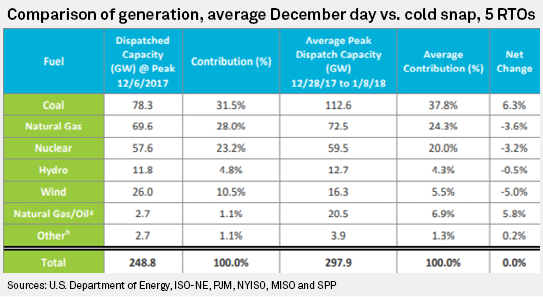After a failed attempt to secure market support for certain coal-fired and nuclear power plants, the U.S. Department of Energy released a study March 27 that said future retirements of those plants could have an adverse impact on grid reliability during severe weather events.
The 46-page report echoed past statements from the DOE that "baseload" nuclear and coal-based plants are crucial to ensuring a stable power system and their ability to store fuel on-site makes them more resilient than other energy sources during extreme weather.
The DOE's National Energy Technology Laboratory conducted an analysis of the "bomb cyclone" winter storm that hit much of the eastern U.S. in late December 2017 and early January 2018. Among other takeaways, the report noted that during the storm, coal provided 55% of the incremental daily generation across six regional organized power markets: ISO New England, New York ISO, PJM Interconnection, Midcontinent ISO, Southwest Power Pool and Electric Reliability Council of Texas. Combined fossil and nuclear energy plants provided 89% of electric generation during peak demand across all six regions, much of it from baseload fossil fuel-fired facilities.
The report defined baseload resources, as those that have historically operated at a more than 65% annualized capacity factor.
In the PJM, the DOE said coal provided three times the incremental generation from natural gas and twelve times that from nuclear units. "Without available capacity from partially utilized coal units, PJM would have experienced shortfalls leading to interconnect-wide blackouts," the report said.
Across the six grid operators followed in the study, coal units generated 63% of the increase in electric output during the bomb cyclone event, followed by oil/dual-fueled plants at 25%, natural gas plants at 20% and nuclear generation at 5%.
 |
In addition to touting the benefits of coal and nuclear energy, the DOE highlighted cost and operational issues for natural gas-based and renewable energy during the cold snap. The report said insufficient gas pipeline capacity and increased demand caused spot gas prices to surge by over 300% in the Northeast and mid-Atlantic during the bomb cyclone. Available wind energy was 12% lower during the bomb cyclone than a typical winter day, requiring fossil fuel generation to compensate for the decline, according to the study.
The DOE went on to warn that the U.S. may be underestimating the amount of future coal and nuclear retirements, "which could give rise to reliability concerns and an inability to meet projected electricity demand." The agency said the U.S. Energy Information Administration's projections for 41 GW of coal retirements and 10 GW of nuclear closures by 2025 do not capture the full potential loss of capacity in the coming decades, noting that many remaining coal plants will be over 60 years old by 2040.
"As the age of the coal fleet rises and the challenges of low gas prices and subsidized, mandated, and/or reduced cost of intermittent renewables continue, the coal units will experience repeated cycling," the report said.
The study reinforces recent DOE efforts to support struggling coal and nuclear plants that are facing increased competition from attractively priced gas generation and rising renewable output.
In September 2017, the DOE asked the Federal Energy Regulatory Commission to craft a rule ensuring coal and nuclear plants operating in wholesale markets can recover all of their costs plus a return on investment if they have at least 90 days of fuel inventory on-site. FERC eventually rejected the proposal, saying the DOE had not shown that the uptick in coal and nuclear retirements posed a risk to resilience, but the commission launched a new proceeding looking at possible resilience issues in competitive markets.
The DOE study repeated calls to change wholesale market rules to benefit coal and nuclear facilities, citing their importance during the bomb cyclone. "Markets do not currently compensate resilience, and thus that capability is steadily diminishing due to competitive pressures of ongoing, baseload power plant early retirements," the DOE said.
In comments on FERC's new resilience proceeding, the coal-heavy PJM said it was evaluating possible changes in how it compensates energy resources in order to ensure resilience and reliability, but grid operators largely did not express alarm at past and future coal and nuclear plant retirements.
At a Jan. 23 hearing before a U.S. Senate committee, PJM President and CEO Andy Ott said the region did not experience any major operational setbacks during the bomb cyclone and PJM's grid and generation fleet performed well. But he said power prices in the PJM need to better reflect the resources that are running, including coal-fired plants.
Critics of the DOE's grid resilience proposal said such a rule would disrupt competitive markets and pointed out the low rate of power outages stemming from fuel supply issues. In its own assessment of grid reliability released in August 2017, the DOE said over 90% of blackouts are caused by problems at the distribution system level.



